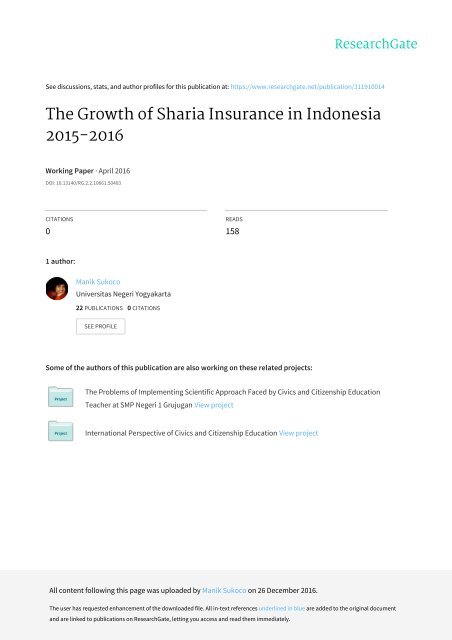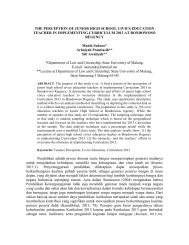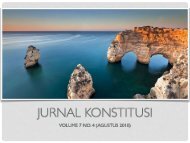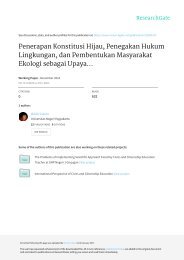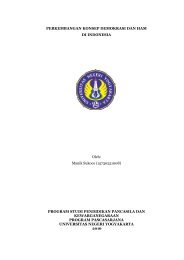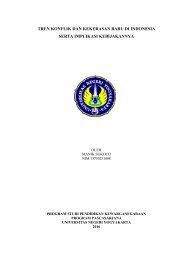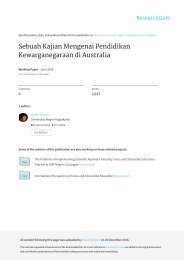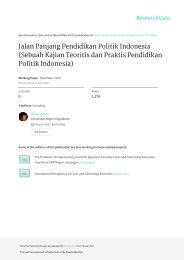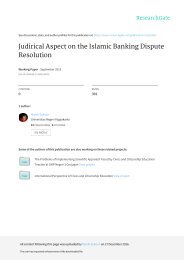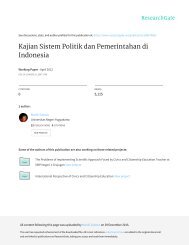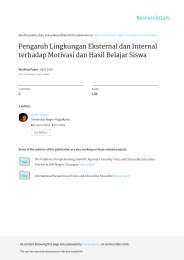The Growth of Sharia Insurance in Indonesia 2015-2016
This research is intended to analyze and to forecast the growth of sharia insurance in Indonesia, using Autoregressive Integrated Moving Average (ARIMA) analysis. The variables used in this research are assets, investments, premium, and claims. Quarterly time series data from period quarter I (March 2007) up to quarter IV (December 2014), gathered from Islamic Insurance Statistic published by Otoritas Jasa Keuangan (OJK), are being carefully examined and academically used to predict sharia insurance growth in 2016. As a result, based on ARIMA analysis, this research show that the growth of sharia insurance in Indonesia has fluctuated, confidently it can be predicted that nominally it will increase in each quarter, including its assets, investments, premium and claims. This research would especially contribute to the sharia insurance companies to formulate their strategies in the future.
This research is intended to analyze and to forecast the growth of sharia insurance in Indonesia, using Autoregressive Integrated Moving Average (ARIMA) analysis. The variables used in this research are assets, investments, premium, and claims. Quarterly time series data from period quarter I (March 2007) up to quarter IV (December 2014), gathered from Islamic Insurance Statistic published by Otoritas Jasa Keuangan (OJK), are being carefully examined and academically used to predict sharia insurance growth in 2016. As a result, based on ARIMA analysis, this research show that the growth of sharia insurance in Indonesia has fluctuated, confidently it can be predicted that nominally it will increase in each quarter, including its assets, investments, premium and claims. This research would especially contribute to the sharia insurance companies to formulate their strategies in the future.
Create successful ePaper yourself
Turn your PDF publications into a flip-book with our unique Google optimized e-Paper software.
See discussions, stats, and author pr<strong>of</strong>iles for this publication at: https://www.researchgate.net/publication/311910014<br />
<strong>The</strong> <strong>Growth</strong> <strong>of</strong> <strong>Sharia</strong> <strong>Insurance</strong> <strong>in</strong> <strong>Indonesia</strong><br />
<strong>2015</strong>-<strong>2016</strong><br />
Work<strong>in</strong>g Paper · April <strong>2016</strong><br />
DOI: 10.13140/RG.2.2.10661.50403<br />
CITATIONS<br />
0<br />
READS<br />
158<br />
1 author:<br />
Manik Sukoco<br />
Universitas Negeri Yogyakarta<br />
22 PUBLICATIONS 0 CITATIONS<br />
SEE PROFILE<br />
Some <strong>of</strong> the authors <strong>of</strong> this publication are also work<strong>in</strong>g on these related projects:<br />
<strong>The</strong> Problems <strong>of</strong> Implement<strong>in</strong>g Scientific Approach Faced by Civics and Citizenship Education<br />
Teacher at SMP Negeri 1 Grujugan View project<br />
International Perspective <strong>of</strong> Civics and Citizenship Education View project<br />
All content follow<strong>in</strong>g this page was uploaded by Manik Sukoco on 26 December <strong>2016</strong>.<br />
<strong>The</strong> user has requested enhancement <strong>of</strong> the downloaded file. All <strong>in</strong>-text references underl<strong>in</strong>ed <strong>in</strong> blue are added to the orig<strong>in</strong>al document<br />
and are l<strong>in</strong>ked to publications on ResearchGate, lett<strong>in</strong>g you access and read them immediately.
<strong>The</strong> <strong>Growth</strong> <strong>of</strong> <strong>Sharia</strong> <strong>Insurance</strong> <strong>in</strong> <strong>Indonesia</strong> <strong>2015</strong> – <strong>2016</strong><br />
Manik Sukoco<br />
Email: itsmanik@fastmail.net<br />
Abstract<br />
This research is <strong>in</strong>tended to analyze and to forecast the growth <strong>of</strong> sharia<br />
<strong>in</strong>surance <strong>in</strong> <strong>Indonesia</strong>, us<strong>in</strong>g Autoregressive Integrated Mov<strong>in</strong>g Average<br />
(ARIMA) analysis. <strong>The</strong> variables used <strong>in</strong> this research are assets, <strong>in</strong>vestments,<br />
premium, and claims. Quarterly time series data from period quarter I (March<br />
2007) up to quarter IV (December 2014), gathered from Islamic <strong>Insurance</strong><br />
Statistic published by Otoritas Jasa Keuangan (OJK), are be<strong>in</strong>g carefully<br />
exam<strong>in</strong>ed and academically used to predict sharia <strong>in</strong>surance growth <strong>in</strong> <strong>2016</strong>. As a<br />
result, based on ARIMA analysis, this research show that the growth <strong>of</strong> sharia<br />
<strong>in</strong>surance <strong>in</strong> <strong>Indonesia</strong> has fluctuated, confidently it can be predicted that<br />
nom<strong>in</strong>ally it will <strong>in</strong>crease <strong>in</strong> each quarter, <strong>in</strong>clud<strong>in</strong>g its assets, <strong>in</strong>vestments,<br />
premium and claims. This research would especially contribute to the sharia<br />
<strong>in</strong>surance companies to formulate their strategies <strong>in</strong> the future.<br />
Keywords<br />
<strong>Sharia</strong> <strong>Insurance</strong>, ARIMA, Islamic <strong>Insurance</strong> Statistic<br />
Strong economic growth comb<strong>in</strong>ed with the sav<strong>in</strong>g <strong>in</strong>crement as well as the<br />
growth <strong>of</strong> middle class economy has been a good signal for sharia life <strong>in</strong>surance<br />
(Republika, May 1, 2013). Ernst and Young (2010) released that dur<strong>in</strong>g 2007 to<br />
2008, premium or contribution <strong>of</strong> sharia <strong>in</strong>surance reached 28% <strong>of</strong> all economic<br />
activities <strong>in</strong> the world, which reached 5,3 billion USD. Agust<strong>in</strong>a (2011) stated that<br />
Islamic countries could generate the premium until 1,7 billion USD. In 2009, the<br />
ratio between premium <strong>in</strong>come toward Gross Domestic Bruto (GDP) <strong>of</strong> Islamic<br />
countries reached 1,3%. In addition, accord<strong>in</strong>g to Jhongpita (2011), <strong>in</strong> the<br />
develop<strong>in</strong>g countries, the overall premium reached higher ratio <strong>of</strong> 2,8% toward<br />
the GDP, while <strong>in</strong> 2011 the growth <strong>of</strong> Product Domestic Bruto (PDB) <strong>of</strong> <strong>Indonesia</strong><br />
lied on the number <strong>of</strong> 6,5% and was predicted to cont<strong>in</strong>uously grow. This growth<br />
has been <strong>in</strong>fluenced by domestic consumption which is averaged <strong>in</strong> 65% from the<br />
total <strong>of</strong> PDB dur<strong>in</strong>g some years later. However, the market <strong>of</strong> sharia <strong>in</strong>surance <strong>in</strong><br />
<strong>Indonesia</strong> has not been managed well, although it have great and mature<br />
opportunity. It can be seen from the penetration <strong>of</strong> life <strong>in</strong>surance and its loss lied<br />
only on the number <strong>of</strong> 1,78% <strong>of</strong> PDB <strong>in</strong> 2011. In contrast, the average <strong>in</strong>dividual<br />
ability to pay the premium <strong>of</strong> life <strong>in</strong>surance was only 44 USD (Republika, May 1,<br />
2013). <strong>The</strong> number <strong>of</strong> <strong>in</strong>surance companies and companies that concern on<br />
reassurance us<strong>in</strong>g sharia pr<strong>in</strong>ciple by December 31, 2013 was 49 companies. <strong>The</strong>y<br />
were divided <strong>in</strong>to 5 sharia <strong>in</strong>surance companies (claimed as purely sharia), 41<br />
<strong>in</strong>surance companies which have sharia unit and 3 reassurance companies which<br />
have sharia one. <strong>The</strong> development <strong>of</strong> sharia <strong>in</strong>surance premium acquisition <strong>in</strong><br />
<strong>Indonesia</strong> until 2013 showed a significant <strong>in</strong>crement at the average <strong>of</strong> 42%<br />
compared to the year before.
Up until December 2013, the total <strong>of</strong> sharia <strong>in</strong>surance premium was IDR 7, 19<br />
trillion. However, <strong>in</strong> the macro level, the contribution <strong>of</strong> premium bruto <strong>of</strong> sharia<br />
<strong>in</strong>surance toward the Gross Domestic Bruto (GDP) was 0,11% <strong>in</strong> 2013 (Report <strong>of</strong><br />
<strong>Sharia</strong> F<strong>in</strong>ance Development OJK 2013). Webb & Beck (2002) demonstrated that<br />
<strong>in</strong> the long term the function <strong>of</strong> <strong>in</strong>surance demand has been <strong>in</strong>fluenced by Gross<br />
Domestic Bruto (GDP). <strong>The</strong> demand function <strong>of</strong> <strong>in</strong>surance represent some<br />
<strong>in</strong>dicators, such as (1). <strong>in</strong>surance penetration, which is the ratio <strong>of</strong> <strong>in</strong>surance<br />
premium number compared to the level <strong>of</strong> product domestic bruto; (2). <strong>in</strong>surance<br />
density, is the ratio <strong>of</strong> <strong>in</strong>surance premium number compared to the number <strong>of</strong><br />
the population; (3) <strong>in</strong>surance <strong>in</strong> private sav<strong>in</strong>g, is the ratio <strong>of</strong> the <strong>in</strong>surance<br />
premium number to the amount <strong>of</strong> people sav<strong>in</strong>g. From the premium bruto<br />
contribution, market share <strong>of</strong> sharia <strong>in</strong>surance toward national <strong>in</strong>surance was<br />
4,41%, sharia life <strong>in</strong>surance was 4, 65%, while the common <strong>in</strong>surance was 3,81<br />
percent. If it is compared to gross domestic product, <strong>in</strong>dustrial penetration <strong>of</strong><br />
sharia <strong>in</strong>surance was still be<strong>in</strong>g <strong>in</strong> low position (KRjogja.com, February 6, <strong>2015</strong>).<br />
Market Share <strong>of</strong> <strong>Insurance</strong> us<strong>in</strong>g <strong>Sharia</strong> Pr<strong>in</strong>ciples<br />
(Source: analyzed <strong>in</strong>surance statistic)<br />
Information<br />
Policy/<strong>in</strong>sured<br />
2012 2013<br />
Overal Life <strong>Insurance</strong> 44.182.188 54.118.758<br />
<strong>Sharia</strong> Life <strong>Insurance</strong> 4.488.198 4.306.008<br />
<strong>The</strong> number <strong>of</strong> people be<strong>in</strong>g <strong>in</strong>sured or policy holder from time to time<br />
underwent a significant <strong>in</strong>crement <strong>in</strong> the use <strong>of</strong> life <strong>in</strong>surance service us<strong>in</strong>g<br />
conventional pr<strong>in</strong>ciples. However, this is not comparable with population growth<br />
<strong>of</strong> <strong>Indonesia</strong>n people which grows so rapidly. Accord<strong>in</strong>g to the Population Unit <strong>of</strong><br />
Central Bureau <strong>of</strong> Statistic <strong>of</strong> <strong>Indonesia</strong>, <strong>in</strong> 2010 the number <strong>of</strong> <strong>Indonesia</strong>n<br />
population was 238.518.80 and was forecasted to grow to 255.461.40 <strong>in</strong> <strong>2015</strong>.<br />
<strong>The</strong> <strong>in</strong>dex <strong>of</strong> <strong>in</strong>surance literacy made by OJK showed that <strong>Indonesia</strong>n population<br />
who were well literate toward <strong>in</strong>surance <strong>in</strong>dustry were low, it was only 17,84<br />
percent. It means that every 100 people <strong>in</strong> <strong>Indonesia</strong>, only 18 percent who<br />
understand the <strong>in</strong>surance (KRjogja.com, February 6, <strong>2015</strong>).<br />
From the aforementioned data, it can be <strong>in</strong>ferred that the sharia <strong>in</strong>surance is<br />
grow<strong>in</strong>g so significantly, overall the number <strong>of</strong> market users was still very low<br />
compared to its market potential which is so large as <strong>Indonesia</strong> is a country with<br />
largest number <strong>of</strong> Muslim society as the majority <strong>of</strong> its population and with the<br />
total number <strong>of</strong> over 200 million people (Susilowati, 2011). Regard<strong>in</strong>g to the<br />
discussion, I did conducted a research on apprais<strong>in</strong>g the growth <strong>of</strong> sharia<br />
<strong>in</strong>surance performance that contribute to <strong>in</strong>surance companies as well as to the<br />
community. <strong>The</strong> companies would be able to take the <strong>in</strong>terest <strong>of</strong> the prospective<br />
<strong>in</strong>vestors to entrust their capital to the sharia <strong>in</strong>surance companies. While for the<br />
community, it would <strong>in</strong>crease their trust to the sharia <strong>in</strong>surance companies by<br />
asses<strong>in</strong>g the development <strong>of</strong> the companies’ performance and as a result will
entrust their money to be <strong>in</strong>vested. To make an assessment toward company<br />
performance, it is required to have an <strong>in</strong>strument to measure the growth and<br />
development <strong>of</strong> such company quantitatively us<strong>in</strong>g sets <strong>of</strong> <strong>in</strong>dicators <strong>of</strong> growth <strong>in</strong><br />
sharia <strong>in</strong>surance. Those growth <strong>in</strong>dicators are total asset, total <strong>in</strong>vestment, gross<br />
contribution and gross claims.<br />
<strong>Sharia</strong> <strong>Insurance</strong> and Its <strong>Growth</strong><br />
<strong>The</strong> def<strong>in</strong>ition <strong>of</strong> sharia <strong>in</strong>surance which is well known as at-ta’m<strong>in</strong>, takaful, or<br />
tadhamun is an effort to protect each other and to help many parties through<br />
<strong>in</strong>vestment <strong>in</strong> the form <strong>of</strong> asset and or tabarru’ by giv<strong>in</strong>g the pattern <strong>of</strong> return to<br />
face specific risk us<strong>in</strong>g akad <strong>in</strong> accorandce with sharia (Aziz, 2010, p. 190). In<br />
addition, sharia <strong>in</strong>surance is a conception where there is an assumption that all<br />
participants have a mutual responsibility to the risk <strong>of</strong> other participants. This<br />
mutual responsibility is conducted based on the will<strong>in</strong>g to help each other <strong>in</strong> the<br />
good th<strong>in</strong>gs by spend<strong>in</strong>g a tabarru’ fund or welfare fund (donation) which is used<br />
to resolve the risk (Sula, 2004, p. 293).<br />
<strong>Sharia</strong> <strong>in</strong>surance which is based on help<strong>in</strong>g each other for good th<strong>in</strong>gs and taqwa,<br />
requires all the participants <strong>in</strong> a big family to protect each other and bear the<br />
economic risk among them. Takafuli concept as the basis <strong>of</strong> sharia <strong>in</strong>surance is<br />
enforced on three basic pr<strong>in</strong>ciples; they are (a). Mutually responsible, (b).<br />
Cooperat<strong>in</strong>g and help<strong>in</strong>g each other, (c). protect each other (Sula, 2004, p. 294).<br />
Purba (2006) states that the challenges faced by many companies based on sharia<br />
were varied beg<strong>in</strong> from provid<strong>in</strong>g optimum service, human resource development<br />
and improvement, product development <strong>of</strong> sharia f<strong>in</strong>ance, and the important<br />
need to attend to health level and f<strong>in</strong>ancial performance <strong>of</strong> the company.<br />
<strong>The</strong> robust grow<strong>in</strong>g <strong>of</strong> a company was seen to be the basic requirement for the<br />
success <strong>of</strong> the company. <strong>The</strong> company which grow either its size or its market<br />
would <strong>in</strong>crease company’s pr<strong>of</strong>it. Consequently, the company with high growth<br />
would appeal management talent and large f<strong>in</strong>ancial resources (Heris, 2008, p.<br />
12). Accord<strong>in</strong>g to Feeser and Wilard, as quoted Erva Yulianita (2010, p. 17),<br />
company’s growth is one <strong>of</strong> the most important issues <strong>in</strong> bus<strong>in</strong>ess management<br />
s<strong>in</strong>ce it depicts community’s acceptance and demonstrate the successfulness <strong>of</strong><br />
the company. Zook and Allen, as quoted Erva Yulianita (2010, p. 17), stated that<br />
<strong>in</strong> reality defend<strong>in</strong>g the stability and susta<strong>in</strong>ability <strong>of</strong> growth is someth<strong>in</strong>g<br />
difficult because the research that has been conducted by Zook and Allen<br />
confirmed that there was only one from seven companies which could stay exist<br />
and ga<strong>in</strong> pr<strong>of</strong>itable growth.<br />
<strong>Insurance</strong> growth <strong>in</strong>dicator could be seen from the <strong>in</strong>crement <strong>of</strong> total asset,<br />
development <strong>of</strong> gross premium contribution <strong>of</strong> the <strong>in</strong>surance <strong>in</strong>dustry, the<br />
development <strong>of</strong> <strong>in</strong>festation number <strong>of</strong> <strong>in</strong>surance <strong>in</strong>dustry as well as the number<br />
<strong>of</strong> claims toward <strong>in</strong>surance <strong>in</strong>dustry (<strong>Indonesia</strong> <strong>Insurance</strong> Report, 2011).<br />
F<strong>in</strong>ancial Services Authority established the measurement for sharia <strong>in</strong>surance
growth through its components such as total asset, total <strong>in</strong>vestment, premium<br />
contribution and gross claims. <strong>Insurance</strong> <strong>in</strong>dustry as one <strong>of</strong> the large amount <strong>of</strong><br />
public fund management <strong>in</strong>stitutions, especially life <strong>in</strong>surance, depend highly on<br />
the success <strong>of</strong> manag<strong>in</strong>g <strong>in</strong>vestment <strong>in</strong> the effort to realize the aim <strong>of</strong> the<br />
company. If the <strong>in</strong>vestor is an <strong>in</strong>stitution as the life <strong>in</strong>surance company, so the<br />
ma<strong>in</strong> purpose <strong>of</strong> <strong>in</strong>vestment portfolio is to ga<strong>in</strong> level <strong>of</strong> high return with small<br />
risk to fulfill its responsibility to the policy holder (claim payment) as well as for<br />
the purpose <strong>of</strong> company’s growth (Sula, 2004, p. 379). From this sharia <strong>in</strong>surance<br />
performance <strong>in</strong>dicators, as published by the F<strong>in</strong>ancial Service Authority (OJK)<br />
which are total asset, total <strong>in</strong>vestment, premium contribution and gross claims,<br />
the calculation <strong>of</strong> <strong>in</strong>dicators growth could be formulated as follow:<br />
To <strong>in</strong>form, g is growth (%) and i = total asset, total <strong>in</strong>vestment, gross<br />
contribution, and gross claims, t: time. In this research, the variable that have<br />
been used are total asset, total <strong>in</strong>vestment, gross contribution, and gross claims<br />
as the measurement <strong>of</strong> sharia <strong>in</strong>surance growth. <strong>The</strong> total asset <strong>in</strong> the sharia<br />
<strong>in</strong>surance companies accord<strong>in</strong>g to AAOIFI Bahra<strong>in</strong> (Sula, 2004, p. 400) covers<br />
cash and cash equivalent, <strong>in</strong>vestments, contribution receivables, fixed asset (net),<br />
and development cost. Accord<strong>in</strong>g to Sliw<strong>in</strong>sky (2006) the <strong>in</strong>dicators from this<br />
ratio are calculated from <strong>in</strong>surance technical reserve plus others obligation<br />
compared to total asset value or company’s wealth. <strong>The</strong> higher the <strong>in</strong>dicators the<br />
better company’s growth level. Investment <strong>in</strong> the life <strong>in</strong>surance company<br />
pr<strong>in</strong>cipally is a long term <strong>in</strong>vestment. For that reason, life <strong>in</strong>surance company<br />
commend its fund <strong>in</strong> the long term <strong>in</strong>vestment as much as 2/3 from its total asset<br />
that is be<strong>in</strong>g <strong>in</strong>vested <strong>in</strong> company’s share and bond (Darmawi, 2001, p. 50).<br />
Accord<strong>in</strong>g to Sliw<strong>in</strong>sky (2006) <strong>in</strong>vestments shows a comparation between<br />
<strong>in</strong>vestment which is listed <strong>in</strong> the balance toward capital and <strong>in</strong>surance fund.<br />
<strong>Insurance</strong> fund is the level <strong>of</strong> technical <strong>in</strong>surance reserves. <strong>The</strong> higher this ratio<br />
value, the better company’s f<strong>in</strong>ancial stability.<br />
High growth potential also can be seen from the amount <strong>of</strong> <strong>in</strong>surance premium<br />
where is be<strong>in</strong>g re<strong>in</strong>sured outside <strong>Indonesia</strong>. It becomes one <strong>of</strong> the causes <strong>of</strong><br />
national <strong>in</strong>surance payment balance deficit. Many <strong>of</strong> the <strong>in</strong>surance premium,<br />
which is be<strong>in</strong>g re<strong>in</strong>sured overseas because the retention level or the ability to bear<br />
risk <strong>of</strong> <strong>in</strong>surance companies <strong>in</strong> <strong>Indonesia</strong> is still very low (www.jiwasraya.co.id).<br />
Accord<strong>in</strong>g to Sliw<strong>in</strong>sky (2006) sales pr<strong>of</strong>itability ratio is a company’s ability to<br />
generate pr<strong>of</strong>it from the gross premium <strong>in</strong>come. This ratio specialize the<br />
comparison between gross premium <strong>in</strong>come and company’s net pr<strong>of</strong>it. <strong>The</strong> higher<br />
this <strong>in</strong>dicator would give better level <strong>of</strong> company’s growth.<br />
Claims is an application from the <strong>in</strong>surance participant to obta<strong>in</strong> guarantee from<br />
the loss based on the agreement. In do<strong>in</strong>g so, it is important for the sharia
<strong>in</strong>surance management to solve the claims efficiently (Sula, 2004, p. 260). For<br />
Sliw<strong>in</strong>sky (2006) claim ratio net <strong>of</strong> re<strong>in</strong>surance depict part <strong>of</strong> claims arise from<br />
generat<strong>in</strong>g premium. <strong>The</strong> lowest this ratio would result <strong>in</strong> common better<br />
f<strong>in</strong>ancial. <strong>The</strong> level <strong>of</strong> claims arose will set the technical f<strong>in</strong>ancial position from<br />
the company’s operation.<br />
Framework <strong>of</strong> Th<strong>in</strong>k<strong>in</strong>g<br />
<strong>The</strong> Level <strong>of</strong> <strong>Sharia</strong> <strong>Insurance</strong> <strong>Growth</strong> <strong>in</strong> <strong>Indonesia</strong><br />
(Source: Modified from Nadia Galuh Hendriana Research)<br />
Autoregressive Integrate Mov<strong>in</strong>g Average Box-Jenk<strong>in</strong> model is a forecast<strong>in</strong>g<br />
technique us<strong>in</strong>g time series model based merely on the behavior <strong>of</strong> the data<br />
variable be<strong>in</strong>g observed (let the data speak for themselves). This Box-Jenk<strong>in</strong><br />
model was technically known as Autoregressive Integrated Mov<strong>in</strong>g Average<br />
(ARIMA). This analysis is different from the structural model <strong>of</strong> causality or the<br />
simultaneous one, <strong>in</strong> which the equation model shows the correlation between<br />
economic variables. <strong>The</strong> ma<strong>in</strong> reason for us<strong>in</strong>g the Box-Jenk<strong>in</strong> technique is<br />
because the movement <strong>of</strong> economic variables be<strong>in</strong>g observed such as the<br />
exchange value, hold<strong>in</strong>g, and <strong>in</strong>flation are difficult to be expla<strong>in</strong>ed us<strong>in</strong>g<br />
economic theories (Widarjono, 2013, p. 267).<br />
<strong>The</strong> forecast<strong>in</strong>g method us<strong>in</strong>g Box-Jenk<strong>in</strong>s (ARIMA-Autoregressive Integrated<br />
Mov<strong>in</strong>g Average) has very good forecast<strong>in</strong>g accuracy for short term forecast,<br />
while for the long term one, the accuracy is not very good. Usually it would tend<br />
to be flat or constant for long term prediction (Setiawan, 2012, p. 2). However, if<br />
the prediction model and the data could not expla<strong>in</strong> best, then the process <strong>of</strong><br />
model determ<strong>in</strong>ation should be repeated. <strong>The</strong> Box-Jenk<strong>in</strong>s model consists <strong>of</strong> a<br />
number <strong>of</strong> models such as autoregressive (AR), mov<strong>in</strong>g average (MA),<br />
autoregressive-mov<strong>in</strong>g average (ARMA) and autoregressive <strong>in</strong>tegrated mov<strong>in</strong>g<br />
average (ARIMA) (Widarjono, 2013, p. 267).
This research has exam<strong>in</strong>ed four hypotheses. H1 : Total Asset; there is a<br />
significant coefficient <strong>in</strong> the total asset which is tested us<strong>in</strong>g the best ARIMA<br />
model. H2: Total Invest; there is a significant coefficient <strong>in</strong> the total <strong>in</strong>vestment<br />
which is tested us<strong>in</strong>g the best ARIMA model. H3: Gross contribution; there is a<br />
significant coefficient <strong>in</strong> the gross contribution which is tested us<strong>in</strong>g best ARIMA<br />
model. H4: Gross claims; there is a significant coefficient <strong>in</strong> the gross claims<br />
which are tested us<strong>in</strong>g the best ARIMA model. In addition, this research is us<strong>in</strong>g<br />
quantitative data, emphasiz<strong>in</strong>g on theoretical test<strong>in</strong>g through research variables<br />
measurement us<strong>in</strong>g numbers and conduct<strong>in</strong>g a data analysis by employ<strong>in</strong>g<br />
statistical procedures (Indriantoro and Supomo, 2012, p. 12). This research aims<br />
to reconstruct the past phenomenon systematically, objectively, and accuratively<br />
to expla<strong>in</strong> current phenomenon or to anticipate the future phenomenon (Sangadji<br />
and Sopiah, 2010, p. 21).<br />
Sample is a part <strong>of</strong> the number and characteristics controlled by the population<br />
(Sangadji and Sopiah, 2010, p. 186). So, the sample for this research is annual<br />
f<strong>in</strong>ancial report <strong>of</strong> the sharia <strong>in</strong>surance companies which has been published by<br />
the F<strong>in</strong>ancial Service Authority dur<strong>in</strong>g the period <strong>of</strong> 2007 quarter I until 2014<br />
quarter IV. <strong>The</strong> data obta<strong>in</strong>ed <strong>in</strong> the form <strong>of</strong> annual data, the annual data is then<br />
be<strong>in</strong>g <strong>in</strong>terpolated <strong>in</strong>to quarter data us<strong>in</strong>g E-views, so that ga<strong>in</strong>ed research<br />
sample <strong>in</strong> the form <strong>of</strong> quarter data such as sharia <strong>in</strong>surance statistics <strong>in</strong> <strong>Indonesia</strong><br />
quarter I year 2007 until quarter IV year 2014. Sample determ<strong>in</strong>ation is done<br />
us<strong>in</strong>g purposive sampl<strong>in</strong>g technique as a method for sample determ<strong>in</strong>ation based<br />
on specific criteria (Sangadji and Sopiah, 2010, p.188). In this research the<br />
number <strong>of</strong> sample used is 32 samples which are the statistical data <strong>of</strong> sharia<br />
<strong>in</strong>surance <strong>in</strong> <strong>Indonesia</strong> quarter I year 2007 until quarter IV year 2014.<br />
<strong>The</strong> source <strong>of</strong> data used was secondary data. Secondary data is data which are<br />
gathered <strong>in</strong> the form <strong>of</strong> fixed data and has been processed by other parties,<br />
usually <strong>in</strong> the form <strong>of</strong> publication (Susanti, 2010, p. 15). <strong>The</strong> secondary data <strong>of</strong><br />
this research was sharia <strong>in</strong>surance statistics on the website <strong>of</strong> F<strong>in</strong>ancial Service<br />
Authority. <strong>The</strong> dependent variable <strong>in</strong> this research was the forecast <strong>of</strong> the level <strong>of</strong><br />
growth <strong>of</strong> sharia <strong>in</strong>surance <strong>in</strong> <strong>Indonesia</strong>. While the measurement <strong>in</strong>dicator is<br />
us<strong>in</strong>g growth theory below:<br />
Information: g is growth (%) and i = Asset, Investment, Gross contribution, Gross<br />
claims t: time.
<strong>The</strong> <strong>Growth</strong> <strong>of</strong> Full Fledge <strong>Sharia</strong> <strong>Insurance</strong> Company and <strong>Sharia</strong><br />
Bus<strong>in</strong>ess Unit (Source: Statistical processed data <strong>of</strong> sharia <strong>in</strong>surance)<br />
Based on the above table, the growth <strong>of</strong> sharia <strong>in</strong>surance company especially the<br />
full-fledged and sharia bus<strong>in</strong>ess unit <strong>in</strong> <strong>Indonesia</strong> underwent a drastic <strong>in</strong>crement<br />
from 2007 until 2014. It can be seen from its growth <strong>in</strong>dicators, <strong>in</strong>clud<strong>in</strong>g asset,<br />
<strong>in</strong>vestment, contribution/ premium, and claims from 2007 until 2014 that show<br />
significant growth. It also <strong>in</strong>dicate that sharia <strong>in</strong>surance role <strong>in</strong> <strong>Indonesia</strong> was<br />
also grow<strong>in</strong>g even though the economic condition <strong>of</strong> the country has not been<br />
quite stable.<br />
<strong>The</strong> <strong>in</strong>crement <strong>of</strong> sharia <strong>in</strong>surance correlated closely to the development <strong>of</strong> sharia<br />
<strong>in</strong>surance <strong>in</strong> national level. In relation to the publication <strong>of</strong> sharia f<strong>in</strong>ance<br />
development report <strong>in</strong> 2013, the development <strong>of</strong> bus<strong>in</strong>essman number based on<br />
the belief that the potentials <strong>of</strong> market for Non-Bank F<strong>in</strong>ancial Industry (NBFI) is<br />
still big as well as product development and services <strong>of</strong> NBFI <strong>in</strong> accommodat<strong>in</strong>g<br />
public need and preference.<br />
Besides, the causes <strong>of</strong> sharia <strong>in</strong>surance development and future <strong>in</strong> <strong>Indonesia</strong> are<br />
still widely opened. Strong economic growth comb<strong>in</strong>ed with the development <strong>of</strong><br />
sav<strong>in</strong>g level and the development <strong>of</strong> middle class economy is a good sign for<br />
sharia life <strong>in</strong>surance <strong>in</strong>dustry (Republika.co.id, May, 1, 2013). It shows that sharia<br />
<strong>in</strong>surance <strong>in</strong> <strong>Indonesia</strong> especially asset, <strong>in</strong>vestment, contribution/premium and<br />
claim from time to time experienced a growth nom<strong>in</strong>ally from 2007 to 2014.<br />
ARIMA Result and Its Prediction<br />
This research used variables which is the <strong>in</strong>dicators from the level <strong>of</strong> <strong>in</strong>surance<br />
growth level: asset, <strong>in</strong>vestment, gross contribution, and gross claims. Those<br />
variables would be forecasted to see the growth <strong>of</strong> sharia <strong>in</strong>surance <strong>in</strong> the future.<br />
Those prediction was us<strong>in</strong>g the data series <strong>of</strong> yesteryear for which is then<br />
processed by employ<strong>in</strong>g the method <strong>of</strong> Box- Jenk<strong>in</strong>s (ARIMA) through various<br />
level <strong>of</strong> forecast. Those analytical steps are as follow:<br />
Stationary Test<br />
<strong>The</strong> first step that has been conducted is by do<strong>in</strong>g a stationary test toward all<br />
variables us<strong>in</strong>g unit root test, purpos<strong>in</strong>g to know whether or not the data<br />
comprised a unit root, if it conta<strong>in</strong>s a unit root then the data is not stationary<br />
(Hendriana, 2011, p. 88) and to know how many times the differentiation should<br />
be conducted so that the data series could become a stationary. Unit root test<strong>in</strong>g<br />
<strong>in</strong> this research is conducted by the test <strong>of</strong> Augmented Dickey-Fuller (ADF) for<br />
stationary data if the value <strong>of</strong> ADF statistics is the value <strong>of</strong> critical value<br />
(Hendriana, 2011, p. 88).
No<br />
Stationary Test <strong>in</strong> the 2nd difference Level (Source: Data processed)<br />
Variable Name<br />
ADF<br />
Statistics<br />
Crtitical<br />
Values 5%<br />
Prob<br />
Information<br />
1 Asset -6.568380 -3.574244 0.0000 Stationary<br />
2 Investment -6.503890 -3.574244 0.0000 Stationary<br />
3<br />
Contribution/<br />
premium<br />
-6.773465 -3.574244 0.0000 Stationary<br />
4 Claim -6.609040 -3.574244 0.0000 Stationary<br />
Based on the above table, stationary test on the level <strong>of</strong> 2nd difference shows that<br />
the asset was significant, s<strong>in</strong>ce the value <strong>of</strong> ADF statistics (-6.568380) < (-<br />
3.574244) from the critical value grade, so it can be considered that the data<br />
series asset is stationary. For the <strong>in</strong>vestment variable, contribution/premium and<br />
claims were also significant on α= 5%, S<strong>in</strong>ce the ADF statistical value <strong>of</strong><br />
<strong>in</strong>vestment (-6.503890) < (-3.574244) <strong>of</strong> critical value grade, and the value <strong>of</strong><br />
ADF statistic for contribution/premium (-6.773465) < (-3.574244) the grade <strong>of</strong><br />
critical value, with ADF statistical value for claims (-6.609040) < (-3.574244) its<br />
critical value. Those showed the data series <strong>of</strong> <strong>in</strong>vestment,<br />
contribution/premium, and claims has been stationary <strong>in</strong> its mean.<br />
Model Identification<br />
Quot<strong>in</strong>g Arifiani, Hendriana (2011, p. 91) argues that after the data time series<br />
become stationary, the next step is determ<strong>in</strong><strong>in</strong>g the ARIMA model (p,d,q) which<br />
is appropriate (tentative), by means <strong>of</strong> determ<strong>in</strong><strong>in</strong>g some p,d, and q. In choos<strong>in</strong>g<br />
how many p and q can be supported by exam<strong>in</strong><strong>in</strong>g the functional pattern <strong>of</strong><br />
autocorrelation and partial autocorrelation (correlogram).<br />
ARIMA Model (Source : Data processed)<br />
No Variable ARIMA Model<br />
1 Asset (1, 2, 1)<br />
2 Investment (2, 2, 2)<br />
3 Contribution/Premium (1, 2, 1)<br />
4 Claims (1, 2, 1)<br />
Accord<strong>in</strong>g to the table, it is known that the beg<strong>in</strong>n<strong>in</strong>g model <strong>of</strong> ARIMA for asset<br />
variable 1,2,1 are AR(1) MA(1), through 2nd difference, then for the beg<strong>in</strong>n<strong>in</strong>g<br />
model <strong>of</strong> ARIMA for <strong>in</strong>vestment variable 2,2,2 are AR (2), MA (2) through 2nd<br />
difference, the beg<strong>in</strong>n<strong>in</strong>g ARIMA model for contribution/premium 1,2,1, are AR<br />
(1), MA (1) through 2nd difference and the beg<strong>in</strong>n<strong>in</strong>g <strong>of</strong> ARIMA model for claims<br />
are 1,2,1 which are AR (1), MA (1) through 2nd difference.<br />
ARIMA Estimation<br />
<strong>The</strong> next step is do<strong>in</strong>g an estimation or try out. Estimation is needed to determ<strong>in</strong>e<br />
the appropriate ARIMA model to be used <strong>in</strong> the research. Each <strong>of</strong> the variable is<br />
be<strong>in</strong>g estimated to ga<strong>in</strong> the right model for forecast<strong>in</strong>g. <strong>The</strong> choos<strong>in</strong>g for the best<br />
ARIMA model could also be seen from the value <strong>of</strong> Akaike Info Criterion (AIC)<br />
and Schwarz Criterion (SIC). Model with less AIC and SIC value would have<br />
better quality and that k<strong>in</strong>d <strong>of</strong> model is determ<strong>in</strong>ed to be employed <strong>in</strong> the<br />
research (W<strong>in</strong>arno, 2009, pp. 7-31).
ARIMA Prediction<br />
After obta<strong>in</strong><strong>in</strong>g the proper ARIMA model, the last step is mak<strong>in</strong>g prediction. <strong>The</strong><br />
prediction <strong>of</strong> this research is conducted to the variable <strong>of</strong> asset, <strong>in</strong>vestment,<br />
contribution/ premium, and claims for the first quarter <strong>of</strong> <strong>2015</strong> until the fourth<br />
quarter <strong>of</strong> <strong>2016</strong>.<br />
ARIMA Prediction Result (<strong>in</strong> Billion Rupiahs)<br />
(Source: Data processed)<br />
Year Asset Investment Contribution Claim<br />
<strong>2015</strong> I 31.190 31.609 5215.1 1144.8<br />
<strong>2015</strong> II 32.153 32.586 5284.2 1178.4<br />
<strong>2015</strong> III 33.117 33.564 5353.2 1212.0<br />
<strong>2015</strong> IV 34.080 34.541 5422.2 1245.7<br />
<strong>2016</strong> I 35.044 35.518 5491.3 1279.3<br />
<strong>2016</strong> II 36.008 36.496 5560.3 1313.0<br />
<strong>2016</strong> III 36.971 37.473 5629.3 1346.6<br />
<strong>2016</strong> IV 37.935 38.451 5698.3 1380.2<br />
Based on the prediction, it is shown that asset, <strong>in</strong>vestment, contribution and<br />
claims from the first quarter <strong>in</strong> <strong>2015</strong> until the fourth quarter <strong>in</strong> <strong>2016</strong> demonstrate<br />
<strong>in</strong>crement <strong>in</strong> term <strong>of</strong> its nom<strong>in</strong>al. After gett<strong>in</strong>g prediction result on the nom<strong>in</strong>al <strong>of</strong><br />
asset, <strong>in</strong>vestment, contribution and claims, it is then followed by calculat<strong>in</strong>g<br />
asset, <strong>in</strong>vestment, contribution and claims growth for each quarter.<br />
<strong>The</strong> growth was calculated us<strong>in</strong>g the formula below:<br />
Information: g is growth (%) and i= asset, <strong>in</strong>vestment, contribution and claims, t:<br />
time. So that growth <strong>of</strong> each variable could be counted as follow:<br />
1. Asset growth<br />
Assett = (Assett - Assett-1) / Assett-1 x 100%<br />
2. Investment growth<br />
Investment t = (Investmentt - Investmentt-1) / Investmentt-1 x 100%<br />
3. Contribution growth<br />
Contribution t = (Contributiont – Contribution t-1) / Contribution t-1<br />
x 100%<br />
4. Claims growth<br />
Claim t = (Claim t – Claim t-1) / Claim t-1 x 100%<br />
After mak<strong>in</strong>g a calculation on the variable <strong>of</strong> asset, <strong>in</strong>vestment, contribution and<br />
claims, so the result is showed <strong>in</strong> below:
Quarterly growth prediction <strong>of</strong> sharia <strong>in</strong>surance (<strong>in</strong> %)<br />
(Source: Data processed)<br />
Year Asset Invesment Contribution Claim<br />
<strong>2015</strong> I 3.18 3.19 1.34 3.02<br />
<strong>2015</strong> II 3.08 3.09 1.32 2.93<br />
<strong>2015</strong> III 2.99 2.99 1.30 2.85<br />
<strong>2015</strong> IV 2.90 2.91 1.28 2.77<br />
<strong>2016</strong> I 2.82 2.82 1.27 2.70<br />
<strong>2016</strong> II 2.74 2.75 1.25 2.62<br />
<strong>2016</strong> III 2.67 2.67 1.24 2.56<br />
<strong>2016</strong> IV 2.60 2.60 1.22 2.49<br />
Based on the table, sharia <strong>in</strong>surance growth, consist<strong>in</strong>g <strong>of</strong> asset and <strong>in</strong>vestment<br />
every quarter, is quite stable on the growth level <strong>of</strong> 2,60% and 2,60%, while the<br />
growth <strong>of</strong> contribution and claims experience fluctuatif level <strong>of</strong> growth rate. As a<br />
result, growth forecast <strong>of</strong> sharia <strong>in</strong>surance <strong>in</strong> <strong>Indonesia</strong> displays a decl<strong>in</strong><strong>in</strong>g<br />
growth trend, although it developed nom<strong>in</strong>ally. On the other hand, claims<br />
experienced growth that depicted poor f<strong>in</strong>ancial condition <strong>of</strong> sharia <strong>in</strong>surance<br />
company, because the amount <strong>of</strong> claims should be paid to the policy holders. <strong>The</strong><br />
growth <strong>of</strong> claims have been caused by many th<strong>in</strong>gs one <strong>of</strong> them is natural<br />
disaster.<br />
Accord<strong>in</strong>g to Webb et al (2002), the slow growth performance <strong>of</strong> sharia <strong>in</strong>surance<br />
<strong>in</strong>dustry has been caused by macro-economic growth that can be used as<br />
predictor variable <strong>in</strong> do<strong>in</strong>g <strong>in</strong>surance demand analysis.<br />
Other research support<strong>in</strong>g Web at al (2002) hs been conducted by Kugler and<br />
Ofoghi (2006) <strong>in</strong> England, show<strong>in</strong>g that <strong>in</strong> the long term the function <strong>of</strong><br />
<strong>in</strong>surance demand would be <strong>in</strong>fluenced by Gross Domestic Bruto (GDP).<br />
One <strong>of</strong> the causes <strong>of</strong> sharia <strong>in</strong>surance decl<strong>in</strong>e was the fluctuated economic<br />
condition <strong>of</strong> <strong>Indonesia</strong>n economics that <strong>in</strong> 2007 the economic growth was 6,3%<br />
(yoy), <strong>in</strong> 2008 6,0% (yoy) although the economic experience a decl<strong>in</strong>e but <strong>in</strong><br />
2008 the economic condition was still considered as good. Enter<strong>in</strong>g the third<br />
quarter, economic activities beg<strong>in</strong>n<strong>in</strong>g to decl<strong>in</strong>e, export was decl<strong>in</strong><strong>in</strong>g, the<br />
domestic market sluggish started, the <strong>in</strong>dustry faced market difficulty (APBN<br />
2007-2013).<br />
In 2009 the growth was 4,6% (yoy) considered as decl<strong>in</strong><strong>in</strong>g s<strong>in</strong>ce the rupiahs<br />
exchange rate was also decl<strong>in</strong><strong>in</strong>g and <strong>in</strong> 2009 a global crisis occurred and affected<br />
<strong>Indonesia</strong>n economy. In 2010 the economy grew 6,2% (yoy) because <strong>of</strong> the<br />
development <strong>of</strong> <strong>in</strong>vestment and export, whereas <strong>in</strong> 2011 the economy developed<br />
compared to the previous year <strong>in</strong> 6.5% (yoy). In 2012 it was 6,5% (yoy), developed<br />
to 6,8% <strong>in</strong> 2013 but it became slower <strong>in</strong> 2014 slow <strong>in</strong> the first quarter because real<br />
export contraction. In the first quarter <strong>of</strong> 2014, the economic growth was 5,21%<br />
(yoy). It was slower compared to the fourth quarter <strong>of</strong> 2013 which was 5,72%<br />
(yoy). <strong>The</strong> <strong>in</strong>vestment <strong>in</strong> the first quarter <strong>of</strong> 2014 was <strong>in</strong>creas<strong>in</strong>g, especially<br />
<strong>in</strong>vestment <strong>in</strong> non-build<strong>in</strong>g. <strong>The</strong> <strong>in</strong>vestment grew from 4,4% (yoy) <strong>in</strong> quarter IV
<strong>of</strong> 2013 to 5,1% <strong>in</strong> the quarter I <strong>of</strong> 2014. Inflation <strong>in</strong> 2014 has been recorded as<br />
much as 8,36% sourced from the <strong>in</strong>crement <strong>of</strong> subsidized oil price, electricity<br />
tariff adaptation for family and <strong>in</strong>dustry categories, and the <strong>in</strong>crement <strong>of</strong> gas (12<br />
Kg) price. This <strong>in</strong>fluence toward the decrease level <strong>of</strong> asset, <strong>in</strong>vestment and<br />
contribution premium <strong>of</strong> <strong>Indonesia</strong>n sharia <strong>in</strong>surance (Permana, <strong>2015</strong>, p.14). <strong>The</strong><br />
decl<strong>in</strong>ed <strong>of</strong> premium was caused by the product provided by sharia <strong>in</strong>surance<br />
bus<strong>in</strong>ess holder who have <strong>in</strong>surance program for low <strong>in</strong>come societies.<br />
Consider<strong>in</strong>g that there are still many <strong>of</strong> Muslim society who are relatively have<br />
low <strong>in</strong>come, sharia <strong>in</strong>surance should also provide <strong>in</strong>surance product for those<br />
segment <strong>of</strong> society so that the existence <strong>of</strong> those k<strong>in</strong>d <strong>of</strong> <strong>in</strong>dustry could be<br />
recognized by the public (Laporan Perkembangan Keuangan Syariah, 2013).<br />
Conclusion<br />
This research aimed at understand<strong>in</strong>g the prediction <strong>of</strong> sharia <strong>in</strong>surance growth<br />
<strong>in</strong> <strong>Indonesia</strong> from <strong>2015</strong> until <strong>2016</strong>. <strong>The</strong> variables be<strong>in</strong>g tested <strong>in</strong> this research are<br />
asset, <strong>in</strong>vestment, premium, and claim. Based on the problem identification, data<br />
analysis, and the discussion, it can be concluded that:<br />
1. <strong>The</strong> result <strong>of</strong> growth prediction toward sharia <strong>in</strong>surance us<strong>in</strong>g the variable<br />
<strong>of</strong> asset by employ<strong>in</strong>g ARIMA method has shown best arima mode for an<br />
accurate forecast<strong>in</strong>g. <strong>The</strong> best ARIMA model for asset variable is (2,2,1).<br />
<strong>Sharia</strong> <strong>in</strong>surance growth prediction result <strong>in</strong> the first quarter <strong>of</strong> <strong>2015</strong> until<br />
the fourth quarter <strong>of</strong> <strong>2016</strong> experienced a decl<strong>in</strong>e.<br />
2. <strong>The</strong> result <strong>of</strong> sharia <strong>in</strong>surance prediction us<strong>in</strong>g the variable <strong>of</strong> <strong>in</strong>vestment<br />
by employ<strong>in</strong>g ARIMA method resulted <strong>in</strong> the best model <strong>of</strong> ARIMA for an<br />
accurate forecast<strong>in</strong>g. <strong>The</strong> best ARIMA model for <strong>in</strong>vestment is (2,2,1).<br />
<strong>The</strong> result <strong>of</strong> sharia <strong>in</strong>surance prediction growth <strong>in</strong> the first quarter <strong>of</strong><br />
<strong>2015</strong> until the fourth quarter <strong>of</strong> <strong>2016</strong> showed a decl<strong>in</strong>ed trend.<br />
3. <strong>The</strong> result <strong>of</strong> sharia <strong>in</strong>surance growth prediction us<strong>in</strong>g premium variable<br />
us<strong>in</strong>g ARIMA method or Box Jenk<strong>in</strong>s, resulted <strong>in</strong> the best ARIMA model<br />
for an accurate forecast<strong>in</strong>g. <strong>The</strong> best ARIMA model for the variable <strong>of</strong><br />
asset is (1,2,2). <strong>The</strong> result <strong>of</strong> sharia <strong>in</strong>surance growth prediction <strong>in</strong><br />
<strong>Indonesia</strong> <strong>in</strong> the quarter I <strong>of</strong> <strong>2015</strong> until the quarter IV <strong>of</strong> <strong>2016</strong> experienced<br />
a decl<strong>in</strong>ed trend.<br />
4. <strong>The</strong> result <strong>of</strong> sharia <strong>in</strong>surance growth prediction us<strong>in</strong>g claim variable by<br />
employ<strong>in</strong>g ARIMA method resulted <strong>in</strong> the best ARIMA model for an<br />
accurate forecast<strong>in</strong>g. <strong>The</strong> best ARIMA model for the variable <strong>of</strong> claim is<br />
(1,2,2). <strong>The</strong> prediction result <strong>of</strong> growth claims <strong>of</strong> sharia <strong>in</strong>surance <strong>in</strong><br />
<strong>Indonesia</strong> <strong>in</strong> the quarter I <strong>of</strong> <strong>2015</strong> until quarter IV <strong>of</strong> <strong>2016</strong> experienced a<br />
ris<strong>in</strong>g trend. It means that if the claims <strong>in</strong>creased the <strong>in</strong>surance company<br />
experienced decl<strong>in</strong><strong>in</strong>g growth condition and <strong>in</strong> a poor f<strong>in</strong>ancial position.<br />
<strong>The</strong> sharia <strong>in</strong>surance is expected to formulate new strategies so that the growth <strong>of</strong><br />
sharia <strong>in</strong>surance would experience a ris<strong>in</strong>g trend <strong>of</strong> growth, by focus<strong>in</strong>g on<br />
premium development through develop<strong>in</strong>g sharia <strong>in</strong>surance products which is<br />
affordable for middle and lower class <strong>of</strong> society.<br />
<strong>The</strong> sharia <strong>in</strong>surance is expected to manage its asset and <strong>in</strong>vestment better and<br />
more carefully so the <strong>in</strong>vestment which is employed by the sharia <strong>in</strong>surance<br />
company from the source <strong>of</strong> premium and make sure that the <strong>in</strong>vestment has<br />
been distributed to pr<strong>of</strong>itable <strong>in</strong>vestment and <strong>in</strong>creases the return to the
company so that it develops company’s asset as well as <strong>in</strong>vestment. <strong>The</strong> future<br />
research on this issue could be developed by compar<strong>in</strong>g the prediction <strong>of</strong> sharia<br />
<strong>in</strong>surance with the conventional one.<br />
It is suggested for the future research to lengthen the research period to ga<strong>in</strong><br />
more accurate result.<br />
References<br />
Agust<strong>in</strong>a. M.I. (2011). Development <strong>of</strong> An Early Warn<strong>in</strong>g System for Evaluat<strong>in</strong>g<br />
the Credit Port<strong>of</strong>olio’s Quality: A Case Study on Romania. Prague<br />
Economic Papers, 3.<br />
Aziz, A. (2010). Manajemen Investasi Syariah. Bandung: Alfabeta.<br />
Beck,T. And Webb, I. (2002). Economic, demogrhapic, and Institutional<br />
determ<strong>in</strong>ants <strong>of</strong> life <strong>in</strong>surance consumption across countries. World Bank<br />
and International foundation.<br />
Data Darmawi, H. (2006). Pasar F<strong>in</strong>ancial and Lembaga-lembaga F<strong>in</strong>ancial.<br />
Jakarta : PT Bumi Aksara.<br />
Hendr<strong>in</strong>a, N. G. ( 2011). Analisis Perkembangan dan Prediksi T<strong>in</strong>gkat<br />
Pertumbuhan Bank Syariah di <strong>Indonesia</strong>. Skripsi pada Jurusan<br />
Manajemen Universitas Islam Negeri Syarief Hidayatullah Jakarta,<br />
Jakarta.<br />
Heris, B.S. (2008). Kegagalan Strategi Perusahaan. Jurnal Asuransi No. 26,<br />
2008: 12-16.<br />
Indriantoro, N., Supomo, B. (2009). Metodologi Penelitian Bisnis. Cet. 1.<br />
Yogyakarta: BPFE Yogyakarta<br />
Jhongpita, P. Sukree, S, & Chaiyawat T. (2011). Us<strong>in</strong>g Decision Tree Leaner to<br />
Classify Solvency Position for Thai Non – Life <strong>Insurance</strong> Companies.<br />
International and National Journal <strong>of</strong> the Computer, the Internet and<br />
Management, 19 (3): 41-46.<br />
Permana, S.H. (<strong>2015</strong>). K<strong>in</strong>erja APBN – P 2014 dan Tantangan Ekonomi Tahun<br />
<strong>2015</strong>. Info S<strong>in</strong>gkat Ekonomi dan Kebijakan Publik, Vol VII, No<br />
01/1/P3DI/Januari <strong>2015</strong>.<br />
Purba, R. (2006). Memahami Asuransi di <strong>Indonesia</strong>. Yogyakarta: Aditya media.<br />
Sangadji, E.M and Sopiah. (2010). Metodologi Penelitian Pendekatan Praktis<br />
dalam Penelitian Empiris. Yogyakarta:Andi.<br />
Setiawan, S. (2013). Prospek dan Daya Sa<strong>in</strong>g Sektor Perasuransian <strong>Indonesia</strong> di<br />
tengah Tantangan Integrasi Jasa Keuangan ASEAN. Jakarta: Naga Media.<br />
Sula, M. S. (2004). Asuransi Syariah (Life and General): Konsep dan Sistem<br />
Operasional. Jakarta : Gema Insani.
Widarjono, A.(2013). Ekonometrika Pengantar dan Aplikas<strong>in</strong>ya. Cet. Keempat.<br />
Yogyakarta: UPP STIM YKPN.<br />
W<strong>in</strong>arno, W. W. (2007). Analisis Ekonometrika dan Statistika dengan E-Views.<br />
Yogyakarta: STIM YKPN.<br />
Onl<strong>in</strong>e<br />
Anonym, Asuransi Syariah Tumbuh 40% Tahun 2013, retrieved from<br />
www.republika.co.id/12/27/2014.<br />
Potensi Pertumbuhan Asuransi Syariah tahun 2013 retrieved from<br />
www.jiwasraya.com/12/29/2014.<br />
Laporan Statistik Perasuransian published by Otoritas Jasa Keuangan tahun 2013<br />
retrieved from www. OJK.go.id<br />
Pokok APBN tahun 2007-2013 retrieved from www.perpustakaan.bappenas.go.id<br />
04/24/<strong>2015</strong>.<br />
Data Pokok APBN tahun 2007-2013 retrieved from<br />
www.perpustakaan.bappenas.go.id 04/24/<strong>2015</strong>.


